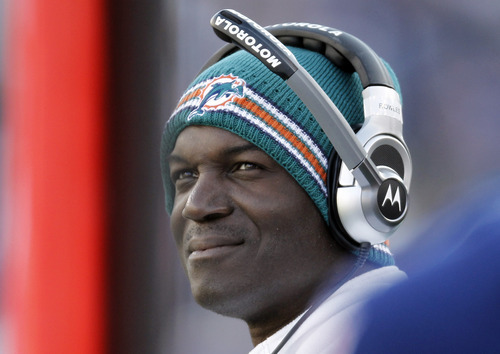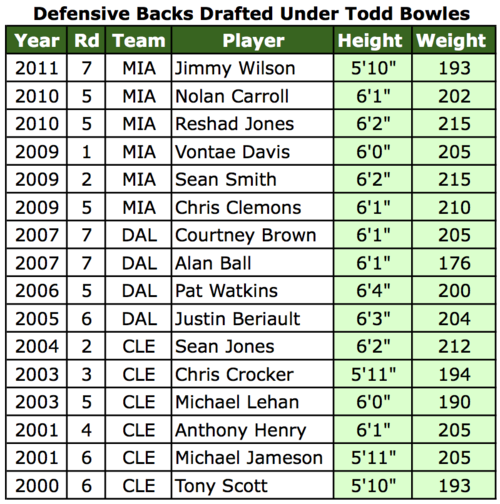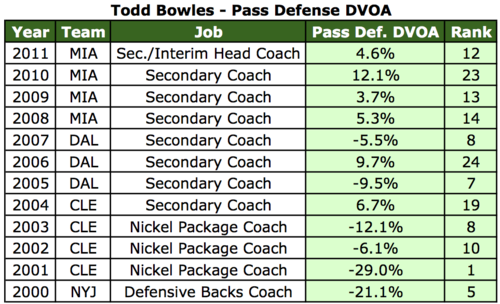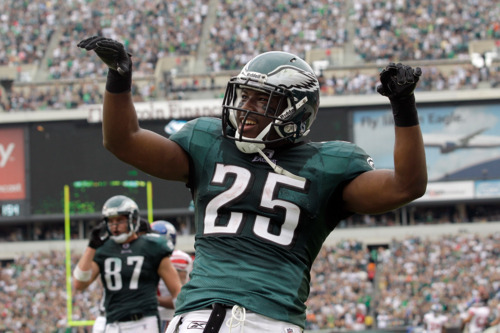This time last year, fresh off a sickening 4-12 season and the long-anticipated firing of one of the best coaches in franchise history, we watched as the Eagles spun their wheels in a coaching search. Fresh off being rejected by some of their top candidates, the organization seemed to be turning toward Gus Bradley, although interviews with Bruce Arians, Brian Kelly, and rumblings about Ken Whisenhunt cast an ominous cloud over the proceedings. It wouldn't be until January 16th that Oregon's belle finally came back around and agreed to a surprise contract in Philadelphia.
Chip Kelly's arrival was met with lots of fanfare, and more than a few skeptics. I won't bother to link to those old columns written about the "college coach" and his "gimmick offense," but suffice it to say that no one's a skeptic now. If anything, we're still underestimating the job he did in his first year. Before the season began, I found all 113 teams in Football Outsiders' database that finished 20th or worse in both offensive and defensive DVOA. Those bad teams had an average overall DVOA improvement of +11.9% in their next season. Kelly's Eagles, as it stands now, posted a +37.8% increase, the third-largest jump on record.
But with an early bounce from the playoffs, the long offseason looms and more changes are inevitable. In today's NFL, huge improvement can always be followed by huge disappointment. In my opinion, the Eagles are much more likely to add to, grow from, and improve off of their 2013 success. But that's far from guaranteed. Here's where the team goes from here:
1. Prune The Dead Wood
Being only a year away from a 4-12 season, there are still a number of players on the Eagles roster who shouldn't be around at training camp next year, whether for reasons of age, performance, or both. Let's do a quick roundup of the top targets.
- Todd Herremans: Even moving back to guard this season didn't seem to halt the Toddfather's decline. He's not the worst guard in the league, but Herremans was the weakest link on the offensive line and you can't expect him to get better heading into his age-32 season. Maybe you offer a restructured contract and the chance to compete for his job, but guard is one of the more fungible starting positions in the league. Time to see if there's a younger, less expensive backup who can take over.
- Trent Cole: The Eagles' longtime DE-turned-OLB passed Clyde Simmons for second place on the Eagles all time sack list with a late season revival. Like Herremans, Cole is heading into his age-32 season and the third year of a contract extension. Despite his resurgence in the second half of the season, Cole never fully adjusted to his linebacker role and couldn't rescue the Eagles' moribund pass rush. We wish him the best, but it's time to move on.
- Brent Celek: Another member of the old guard, Celek turns 29 before the end of the month. He proved his worth blocking, made some key receptions down the stretch, and finished with his highest DVOA since 2008. But Zach Ertz figures to replace him more and more as the down-the-field tight end. Celek is probably still a useful player on this team for his versatility, but he's not worth the $4 million salary he's due next year. Prime (Stache) restructure candidate.
- James Casey: That was always a one year deal, disguised as three years. Not a bad blocker (and the Eagle could use an H-Back/FB from time to time), but barely saw the field the field for anything else. He probably would rather seek his fortune elsewhere too, although maybe he comes back on a reduced salary as the 3rd TE.
- Jason Avant: While Riley Cooper and DeSean Jackson had big DVOA improvement, Avant was one of the few Eagles offensive players to decline this year. He had perhaps his worse season statistically in at least 5 years. Love the leadership, but Avant's not sticking around.
- Patrick Chung: Another guy on a fake 3 year deal who should and will be cut posthaste.
- Alex Henery: I'll go into depth on this once I can crunch more numbers, but Henery isn't worth keeping for beans.
2. Keep An Eye On
There are difficult decisions elsewhere too. Would be surprised if any are cut this offseason, but the team has reason to examine these relationships closely.
- DeMeco Ryans: Leader of the defense and stout run defender who's a major liability in coverage. Turns 29 this summer and has a contract that's easy to do away with. Don't think you cut him yet, but the conversation about the future has to happen.
- Cary Williams & Bradley Fletcher: Let's consider the two corners together. Using a broad stat like passer rating, both of these players were middle of the pack. On a good defense, each is probably a solid #2 corner. They're not going to shut down the other team's top receiver one-on-one, but they'll hold their own against most everyone else and get their share of victories. The question is how highly you value that kind of production. Both Williams and Fletcher have salaries that spike substantially in 2014. Do you let one go to make room for Brandon Boykin? Do you keep them both around another year and draft replacement(s)? Could a restructure/extension be on the table?
- Brandon Graham & Vinny Curry: Both are young and relatively inexpensive, so they probably get another year in this 3-4 transition. But if the right offer came along, Graham especially could be on the block.
- Jason Peters: Nothing big here but he's entering the final year of his contract. Peters was named to his fifth All-Pro team but looked like he lost a step. Eagles hope to already have his replacement on the roster (Lane Johnson), but we can't rule out an extension if he proves he's still capable. Remember, Tra Thomas manned the left tackle spot in Philly until he was 34.
- DeSean Jackson: His salary goes up by over 50% in 2014. Hopefully both he and the team are happy with that. Or not.
3. Are They Worth Keeping?
Retaining your own free agents can be tricky, but this year there aren't too many questions. The big decisions come at wide receiver.
- Jeremy Maclin: The biggest name on this list comes with a huge "What If?" label following his ACL tear last August. I was on record for a Maclin contract extension before the injury and still want him back. The question is how healthy he is and what kind of money he's looking for. The market for wide receivers isn't especially deep, but you don't often see guys get big money coming off knee injuries. A one-year deal with the Eagles might make sense for both sides.
- Riley Cooper: The wide receiver went from racist problem-child to key contributor quickly. He has size, blocks well, and adjusts to deep balls better than most. But on a good team he's a 3rd or 4th wide receiver, and I wouldn't pay him more than that because he'll never be someone who can consistently beat single-coverage. In other words, let him test the market (where there may not be much interest) and only resign him at a backup rate.
- Michael Vick: If he resigns himself to taking a paycheck as a backup, there are worse places to do it than Philadelphia. But maybe he's looking for one last shot at a starting role, and he could get it with the Jets, Jaguars, or somewhere else.
- Donnie Jones: Fantastic job this season. Sign the man.
- Nate Allen: Actually became the best member of the safety corps, which just shows how bad the safeties were. Let him walk.
- Kurt Coleman: Bye.
- Colt Anderson: Never going to be a competent safety, but still a great special teams player. Bring him back and let him compete.
4. Seek Improvement From Youngsters
The last two drafts have been tremendously successful for the Eagles, and they have more than a handful of young players who are forming a new backbone to this team. Their improvement (or decline) will largely decide how the team does in 2014 and beyond. It will also determine who deserves contract extensions and who might not be worth the trouble.
- On defense, the young studs are Brandon Boykin, Mychal Kendricks, and Fletcher Cox. They've all shown flashes, but where is the ceiling? Meanwhile, Bennie Logan and Earl Wolff will be given every opportunity to win starting jobs, but both need to make big leaps this offseason.
- On offense you're looking at Lane Johnson, who had a successful rookie season by mostly avoiding making news. All eyes will be on him next year, to see if he can take over at left tackle after Jason Peters. Zach Ertz also seems inline for a big year as the featured tight end in 2014.
- Nick Foles' offseason matters the most. I'm not convinced he's a franchise quarterback, but he played like one in 2013. Defenses will study him intently next year, and he's unlikely to maintain his fantastic interception rate. Can he improve in other areas to maintain an edge? Foles has earned the benefit of the doubt, but we will find out.
- As for backups: guys like Bryce Brown, Chris Polk, Dennis Kelly, Damion Square, Najee Goode, and Matt Barkley need to prove they're worth trusting. Does Casey Matthews get another year? What about Curtis Marsh, Roc Carmichael, and Julian Vandervelde? Lots of question marks.
5. Identify Obvious Roster Holes
Last offseason, the Eagles had gaping holes across the defense. They drafted a smattering of young players (Wolff, Logan), and added low-to-mid price veterans (Barwin, Williams, Fletcher, Chung, Sopoaga). Due to the relative success of that plan, there aren't as many problem spots as there were a year ago. Here are the main starting spots that need help.
- Safety: It's easy to imagine a future where Wolff is the only guy left from last year, and he's certainly not a sure thing. Major upgrade still needed here.
- Pass Rusher: The Eagles need to generate more of a pass rush. Some of that could come from improvement along the defensive line. But a dynamic pass rushing outside linebacker might make the biggest difference of anyone on the team.
- Wide Receiver: At the very least you bring back Riley Cooper, but ideally you're looking at someone more dynamic across from DeSean. Plus, a new slot receiver to replace Avant would be nice.
- Kicker: Forget field goals for a second. You need a kicker who can consistently reach the end zone on kickoffs.
- Nose Tackle: Logan may be the guy, but my lasting memory of him from 2013 will be the Saints blowing him off the line of scrimmage.
- Guard: If you jettison Herremans.
6. Plan For The Future
While you're logging the problems the team faces right now, it's also time to take stock of the future. Where will the team have holes a year or two from now?
- Cedric Thornton is an exclusive-rights free agent (meaning he can't negotiate with anyone else). One of the few eligible players on the roster probably worth a long term extension.
- Can't count on 30-something offensive linemen to stay healthy in the short term or sustain performance long term. Grab more depth on the offensive line.
- Draft a quarterback. Always draft a quarterback.
- Kendricks looks like a keeper, but Ryans may not have more than a year left. Time to get another young middle linebacker.
- Boykin is probably a long term answer at cornerback, given his stellar performance in the slot. But tied to the Williams & Fletcher questions above, drafting more corners should be high on the list.
7. Find Difference-Makers In Free Agency
Building through the draft is great, but being active at the top of the free agent market is also important. I'm not talking about bringing in another Nnamdi Asomugha, but the Eagles will have plenty of cap space and few in-house players to spend it on. Howie Roseman and company must identify a few key players who can come in and not only fix problem spots in the short term, but are also good long term bets. Some candidates...
- Jairus Byrd: If the Bills safety makes it to free agency, he'll command top dollar. You'd rather he wasn't going into his age-28 season, but he's an All-Pro caliber player still in his prime who would immediately lock down one of the Eagles' safety spots.
- TJ Ward: Fellow second-team All-Pro safety may be slightly less expensive than Byrd. He's also nearly a year younger. Would be a great get.
- Eric Decker: Again, I'd rather just bring Maclin back. But Decker is a much better version of Riley Cooper (albeit at a significant markup). There's also the underachieving Hakeem Nicks out there
- Julian Edelman: Probably can go cheaper in the Avant-replacement department, but there aren't many better slot guys when healthy. Maybe Chip wants more upgrade here.
- Brian Orakpo: Who knows what's going on in D.C. these days? Elite pass rushers don't come cheap, but Orakpo would fit right into a key role on the Eagles defense.
- Donald Butler: If he makes to the open market, you could grab San Diego's young stud middle linebacker and jettison Ryans earlier than planned.
8. Refine The Scheme
To be fair, this is more than one-eighth of the offseason agenda, but it's the one that's least conditional on specific player debates. No matter who the Eagles bring back and who they add, the coaches have to adjust and prepare for a new season.
Chip's offense lit up the league, and ended up second only to Peyton Manning's Broncos on the DVOA chart. He'll be on every defensive coordinator's To-Do list this offseason. I have confidence in the head coach, since he's shown the ability to adjust his offense to two quarterbacks with opposite skill sets. But Kelly needs to stay a step ahead. Defenses stymied some of his schemes, and in some areas he became too predictable by the end of the season (see Cowboys and Saints defenders reading nearly every screen). New weapons will help on that front, but so will new wrinkles. I'm looking forward to seeing what he draws up in 2014.
When you switch to defense and special teams, it's worth noting that the team finished in nearly the same place as 2012 according to DVOA. The defense improved slightly, but there's still a long way to go. Patient, accurate quarterbacks (a species the Eagles were lucky to avoid for long stretches of the season) tore this defense apart with its weakness in coverage down the middle, complete lack of pass rush, and horrible missed tackles. Again, personnel was often at fault there, and this was only year one of a defensive scheme shift. But the scheme can't be as predictable going forward either. Time for Billy Davis to prove he can lead the unit to a renaissance.




 As you can see at right, teams where Bowles has been the secondary coach consistently draft tall defensive backs (
As you can see at right, teams where Bowles has been the secondary coach consistently draft tall defensive backs (
